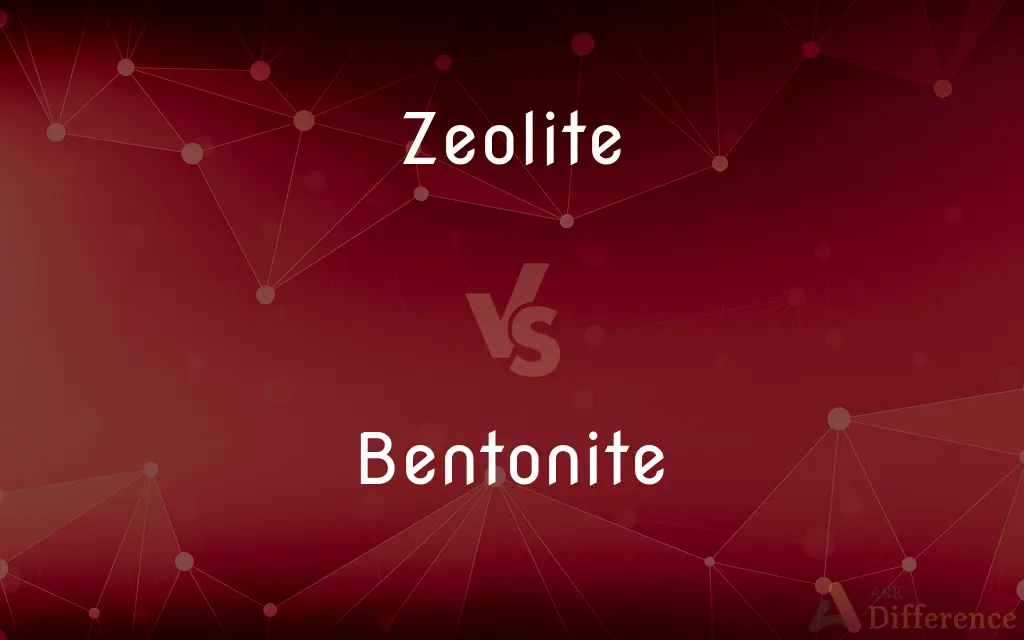Zeolite vs. Bentonite — What's the Difference?
By Fiza Rafique & Maham Liaqat — Updated on March 28, 2024
Zeolite is a naturally occurring, microporous mineral with a unique cage-like structure, used for purification and filtration. Bentonite is a clay composed mainly of montmorillonite, known for its swelling properties and used in various industrial.

Difference Between Zeolite and Bentonite
Table of Contents
ADVERTISEMENT
Key Differences
Zeolite and bentonite are both naturally occurring minerals widely utilized in various applications due to their unique properties, but they differ significantly in composition, structure, and uses. Bentonite, on the other hand, is a type of clay that primarily consists of montmorillonite. It is characterized by its ability to swell and increase in volume when wet, making it useful in sealing and as a lubricant in drilling operations.
The unique structure of zeolite allows it to selectively adsorb gases and liquids, a property highly valued in the petrochemical industry for separating hydrocarbons and in agriculture as a soil amendment to retain nutrients and water. Conversely, bentonite's swelling capacity and plasticity make it ideal for use in the construction of dams and as foundry sand in metal casting processes. Its ability to form a gel-like consistency when mixed with water is also exploited in the beauty and health industry, particularly in detoxifying clay masks and digestive health supplements.
Another key difference lies in their formation. Zeolites are typically formed from the alteration of volcanic ash in alkaline water conditions, giving them a wide distribution in volcanic regions. Bentonite is usually formed from the weathering of volcanic ash, often in the presence of water, leading to large deposits that can be mined and processed.
While zeolites are celebrated for their ion-exchange capacities, enabling their use in water softeners and as catalysts in chemical reactions, bentonite's absorbent and colloidal properties make it a staple in pharmaceuticals, cosmetics, and as a binder in pelletizing processes. The health and safety applications of bentonite, particularly in products designed for internal use or topical applications, underscore its versatility and importance in daily life.
Despite their differences, both minerals are environmentally friendly and offer sustainable options in their respective fields. The choice between zeolite and bentonite depends on the specific requirements of the application, including desired properties like ion-exchange capacity, absorbency, and the ability to swell or maintain a rigid structure.
ADVERTISEMENT
Comparison Chart
Composition
Silicon, aluminum, oxygen in a crystalline structure
Montmorillonite clay
Structure
Microporous, cage-like
Swells when wet, plastic and colloidal properties
Primary Uses
Purification, filtration, agriculture
Drilling, construction, health and beauty products
Formation
Alteration of volcanic ash in alkaline conditions
Weathering of volcanic ash, often in water presence
Key Properties
Ion-exchange, adsorption
Swelling, absorbency, plasticity
Applications
Water treatment, air purification, catalysts
Sealing, lubrication, detoxifying clay masks
Compare with Definitions
Zeolite
Chemical Catalyst.
The petrochemical industry relies on zeolite as a catalyst in refining processes.
Bentonite
Drilling Mud Component.
In oil and gas exploration, bentonite is mixed into drilling fluid to lubricate and cool the drill bit.
Zeolite
Microporous Mineral.
The water filtration system uses zeolite for its ability to trap contaminants.
Bentonite
Swelling Clay.
Bentonite swells to several times its dry volume when exposed to water, making it useful in sealing applications.
Zeolite
Purification Agent.
Zeolite crystals are utilized in air purifiers to remove pollutants and odors.
Bentonite
Cosmetic Ingredient.
Bentonite clay masks are popular in skincare for their ability to draw out impurities from the skin.
Zeolite
Agricultural Amendment.
Farmers use zeolite in soil to improve water retention and nutrient absorption.
Bentonite
Foundry Sand Binder.
Metal casters use bentonite as a binder in foundry sand to maintain the shape of molds.
Zeolite
Ion-exchange Material.
Zeolite is added to laundry detergents to soften water by exchanging magnesium and calcium ions.
Bentonite
Health Supplement.
Bentonite clay is ingested as a detoxifying supplement, absorbing toxins in the digestive system.
Zeolite
Zeolites are microporous, aluminosilicate minerals commonly used as commercial adsorbents and catalysts. The term zeolite was originally coined in 1756 by Swedish mineralogist Axel Fredrik Cronstedt, who observed that rapidly heating a material, believed to have been stilbite, produced large amounts of steam from water that had been adsorbed by the material.
Bentonite
Bentonite () is an absorbent swelling clay consisting mostly of montmorillonite. It usually forms from weathering of volcanic ash in seawater, which converts the volcanic glass present in the ash to clay minerals.
Zeolite
Any one of a family of hydrous alkali-aluminum silicate minerals, whose crystal lattice may enclose or sequester cations of sodium, potassium, magnesium, calcium, strontium, or barium, or a corresponding synthetic compound, used chiefly as molecular filters and ion-exchange agents.
Bentonite
An absorbent aluminum silicate clay formed from volcanic ash and used in various adhesives, cements, and ceramic fillers.
Zeolite
(mineral) Any of several minerals, aluminosilicates of sodium, potassium, calcium or magnesium, that have a porous structure (originally, those which swelled and gave off water when heated); they are used in water softeners and in ion exchange chromatography.
Bentonite
(mineral) Any of several impure clay minerals consisting mostly of montmorillonite.
Zeolite
A term now used to designate any one of a family of minerals, hydrous silicates of alumina, with lime, soda, potash, or rarely baryta. Here are included natrolite, stilbite, analcime, chabazite, thomsonite, heulandite, and others. These species occur of secondary origin in the cavities of amygdaloid, basalt, and lava, also, less frequently, in granite and gneiss. So called because many of these species intumesce before the blowpipe.
Bentonite
A porous clay formed by the decomposition of volcanic ash that swells 5 to 6 times its original volume in the presence of water.
Zeolite
Any of a family of glassy minerals analogous to feldspar containing hydrated aluminum silicates of calcium or sodium or potassium; formed in cavities in lava flows and in plutonic rocks
Bentonite
An absorbent aluminum silicate clay formed from volcanic ash.
Bentonite
An absorbent aluminum silicate clay formed from volcanic ash
Common Curiosities
Are there environmental concerns with mining zeolite and bentonite?
Like all mining operations, environmental impacts include land disturbance and water use, but both minerals are abundant and considered environmentally friendly materials.
Are zeolite and bentonite safe for health applications?
Both minerals are used in health applications; however, their form and the specific application dictate their safety. Always follow product guidelines.
Can bentonite and zeolite remove toxins?
Yes, both minerals can adsorb certain toxins; zeolite through ion exchange and selective adsorption, and bentonite through its absorbent properties.
Can zeolite and bentonite be used interchangeably?
Due to their distinct properties and applications, zeolite and bentonite are not typically used interchangeably.
How do zeolite and bentonite benefit agriculture?
Zeolite improves soil water retention and nutrient efficiency, while bentonite is used to seal ponds and as a soil conditioner.
How does zeolite purify water?
Zeolite traps contaminants and exchanges ions in water, effectively removing heavy metals and other pollutants.
What makes bentonite effective in drilling operations?
Its ability to swell and form a viscous, lubricating slurry helps cool and clean the drill bit, and support the removal of drill cuttings.
Can zeolite be regenerated for repeated use?
Yes, zeolite can be regenerated by heating or chemical treatment, allowing for repeated use in applications like water softening.
What differentiates the types of zeolite?
Different types of zeolite have variations in their pore sizes and chemical composition, affecting their suitability for specific applications.
How does the ion-exchange property of zeolite benefit aquariums?
In aquariums, zeolite can remove ammonia and other toxins, improving water quality and fish health.
Is bentonite suitable for all skin types?
While bentonite clay masks are popular, individuals with dry or sensitive skin should use it cautiously as it can be drying.
Can bentonite clay be ingested?
Certain grades of bentonite clay are marketed for ingestion as detox supplements, but it's important to use products specifically labeled for internal use.
Share Your Discovery

Previous Comparison
Rouse vs. Roust
Next Comparison
Pertain vs. PertinentAuthor Spotlight
Written by
Fiza RafiqueFiza Rafique is a skilled content writer at AskDifference.com, where she meticulously refines and enhances written pieces. Drawing from her vast editorial expertise, Fiza ensures clarity, accuracy, and precision in every article. Passionate about language, she continually seeks to elevate the quality of content for readers worldwide.
Co-written by
Maham Liaqat













































